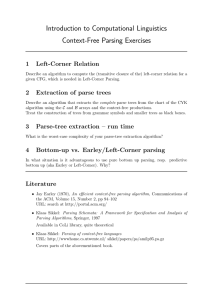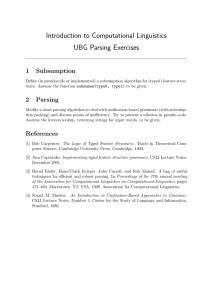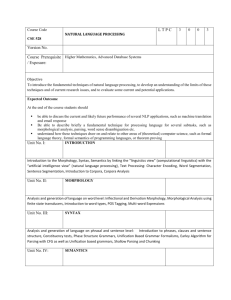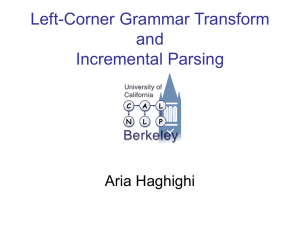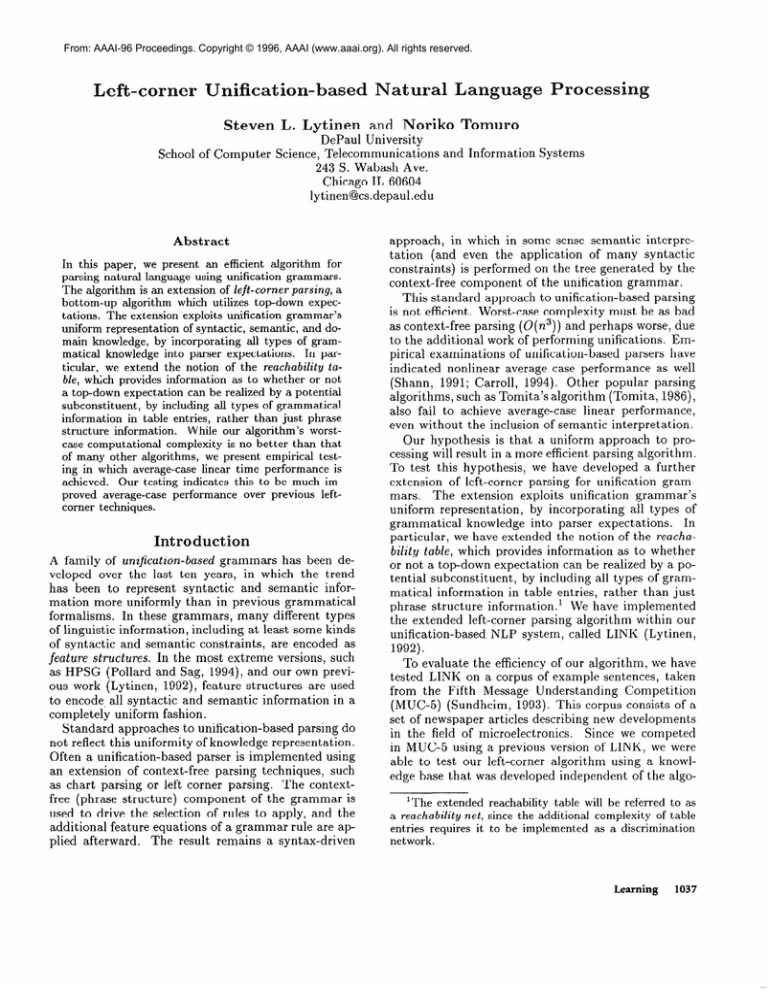
From: AAAI-96 Proceedings. Copyright © 1996, AAAI (www.aaai.org). All rights reserved.
eft-corner
Unification-base
Steven
School of Computer
L. Lytinen
and Nor&o
DePaul University
Science, Telecommunications
243 S. Wabash Ave.
Chicago IL 60604
lytinen@cs.depaul.edu
Abstract
In this paper,
we present an efficient algorithm
for
parsing natural language using unification
grammars.
The algorithm is an extension of left-corner
parsing, a
bottom-up
algorithm
which utilizes top-down
expectations. The extension exploits unification
grammar’s
uniform representation
of syntactic,
semantic,
and domain knowledge, by incorporating
all types of grammatical knowledge into parser expectations.
In particular,
we extend the notion of the reochcsbility table, which provides information as to whether or not
a top-down expectation
can be realized by a potential
subconstituent,
by including all types of grammatical
information
in table entries, rather than just phrase
structure
information.
While our algorithm’s
worstcase computational
complexity
is no better than that
of many other algorithms,
we present empirical testing in which average-case
linear time performance
is
achieved.
Our testing indicates
this to be much improved average-case
performance
over previous leftcorner techniques.
Introduction
A family of unification-based
grammars
has been developed over the last ten years, in which the trend
has been to represent syntactic
and semantic
information more uniformly than in previous grammatical
formalisms.
In these grammars,
many different types
of linguistic information,
including at least some kinds
of syntactic and semantic constraints,
are encoded as
feature structures.
In the most extreme versions, such
as HPSG (Pollard and Sag, 1994), and our own previous work (Lytinen,
1992), feature structures
are used
to encode, all syntactic and semantic information
in a
completely uniform fashion.
Standard approaches to unification-based
parsing do
not reflect this uniformity of knowledge representation.
Often a unification-based
parser is implemented
using
an extension of context-free
parsing techniques,
such
as chart parsing or left corner parsing.
The contextfree (phrase structure)
component
of the grammar is
used to drive the selection of rules to apply, and the
additional feature equations of a grammar rule are apThe result remains a syntax-driven
plied afterward.
Tomuro
and Information
Systems
approach,
in which in some sense semantic interpretation (and even the application
of many syntactic
constraints)
is performed on the tree generated by the
context-free
component of the unification grammar.
This standard approach to unification-based
parsing
is not efficient. Worst-case complexity must be as bad
as context-free
parsing (O(n3)) and perhaps worse, due
to the additional work of performing unifications.
Empirical examinations
of unification-based
parsers have
indicated nonlinear average case performance
as well
(Shann,
1991; Carroll, 1994). Other popular parsing
algorithms, such as Tomita’s algorithm (Tomita, 1986))
also fail to achieve average-case
linear performance,
even without the inclusion of semantic interpretation.
Our hypothesis
is that a uniform approach to processing will result in a more efficient parsing algorithm.
To test this hypothesis,
we have developed a further
extension
of left-corner
parsing for unification
grammars.
The extension
exploits unification
grammar’s
by incorporating
all types of
uniform representation,
grammatical
knowledge into parser expectations.
In
particular,
we have extended the notion of the recschcsbility table, which provides information as to whether
or not a top-down expectation
can be realized by a potential
subconstituent,
by including
all types
of gram-
matical information
in table entries, rather than just
phrase structure information.’
We have implemented
the extended left-corner parsing algorithm within our
unification-based
NLP system, called LINK (Lytinen,
1992).
To evaluate the efficiency of our algorithm,
we have
tested LINK on a corpus of example sentences,
taken
from the Fifth Message Understanding
Competition
(MUC-5)
(Sundh eim, 1993). This corpus consists of a
set of newspaper articles describing new developments
in the field of microelectronics.
Since we competed
in MUC-5 using a previous version of LINK, we were
able to test our left-corner
algorithm using a knowledge base that was developed independent of the algo‘The extended
reachability
table will be referred to as
a reachability
net, since the additional complexity of table
entries requires it to be implemented
as a discrimination
network.
Learning
1037
ca$
sem&m
FOOD
S rule
EAT
Entry for “apple”
Entry for “ate”
ANIMATE
trans
FObD
EAT frame
Figure
1: Example
LINK
grammar
rules
rithm, and compare its performance
on this corpus directly to the performance of more standard approaches
to unification-based
parsing.
A regression analysis of
the data indicates that our algorithm has achieved linear average-case performance
on the MUC-5 corpus, a
substantial
improvement
over other unification-based
parsing algorithms.
This paper is organized as follows: first we present
the uniform knowledge representation
used in LINK to
represent syntactic,
semantic,
and domain knowledge.
We then discuss LINK’s parsing algorithm.
Finally,
we present results of empirical testing, and discuss its
implications.
LINK’s
Knowledge
Representation
All knowledge is encoded in LINK’s unification grammar in the form of feature structures.
A feature consists
of a name and a value. Values may either be atomic or
may themselves be feature structures.
A feature structure may also have an atomic label. Thus, each rule
in LINK’s knowledge base can be thought of as a directed acyclic graph (DAG), whose edges corresponds
to feature names, and whose nodes correspond to feature values.
Figure 1 shows a few simple LINK rules.
The S
rule encodes information
about one possible structure
of a complete sentence.
The cat feature of the root
indicates that this rule is about the syntactic category
S. The numbered arcs lead to subconstituents,
whose
syntactic categories are NP and VP respectively.
Implicit in the numbering of these features is the order
in which the subconstituents
appear in text. In addition, this rule indicates that the VP functions as the
head of the sentence, that the NP is assigned as the
subj of the sentence, and that the NP and VP share
1038
Natural Language
Figure
2: Example
LINK
lexical
entries
and frames
the same agr feature (which encodes the number and
person featires
which must agree between a verb and
its subject).
Each of the other two rules displayed in
figure 1 describes one possible structure for a NP and
a VP, respectively.
Other rules exist for the other
possible structures of these constituents.
The purpose of the head feature is to bundle a group
of other features together.
This makes it easier for a
constituent
to inherit a group of features from one of
its subconstituents,
or vice versa. In this case, the agr
feature is passed up from the noun and verb to the NP
and VP constituents,
to be checked for compatibility
in the S rule. In the other direction, the subj feature is
passed down to the verb, where its semantics is checked
for compatibility
with the semantics of the verb (see
figure 2).
Other rules in LINK’s knowledge base encode lexical
and domain information, such as those in figure 2. Lexical rules typically provide many of the feature values
which are checked for compatibility
in the grammar
rules. For example, the entry for ate indicates that
this verb is transitive,
and thus may be used with the
VP rule in figure 1. Lexical items also provide semanThus, “ate”
tic information,
under the sem feature.
refers to a frame called EAT, and “apple” refers to a
FOOD.
The operation responsible for checking compatibility
of features is unification, which can be thought of as the
combining of information
from two DAGs. The result
of unifying two DAGs is a DAG with all features from
both of the original DAGs. Two DAGs fail to unify if
they share a feature with incompatible
values.
Domain knowledge is encoded in frame definition
rules, such as the EAT frame.
A node whose cat
feature has a frame definition must unify with the definition.
As a result, semantic
type-checking
is per-
Figure
3: LINK
reachability
net entry
formed during parsing, resulting in the construction
of a semantic interpretation.
In these example rules,
since the lexical entry for “ate” unifies the subj of the
this
verb with the actor of its semantic representation,
means the subject of ate must be HUMAN.
Note that LINK’s knowledge base is completely uniform. All rules, including grammar rules, lexical entries, and frame definitions,
are represented as DAGs.
Moreover,
within a DAG there is no structural
distinction between syntactic
and semantic information.
While certain naming conventions are used in the rules
for different kinds of features, such as using the cat feature for the syntactic category of a constituent
and the
sem feature for its semantic representation,
these conventions are only for mnemonic purposes, and play no
special role in parsing.
Parsing
The
Reachability
Net
Context-free
left-corner parsers generate top-down expectations
in order to filter the possible constituents
that are constructed
via bottom-up
rule application.
In order to connect top-down and bottom-up information, a reuchubility table is used to encode what contituents can possibly realize a top-down expectation.
The table is constructed
by pre-analyzing
the grammar in order to enumerate the possible left corner constituents of a particular syntactic category. For example, possible left corners of a NP (noun phrase) might
include DET, ADJ, and N (noun), but not PREP.
In most left-corner unification-based
parsers (e.g., see
Carroll, 1994)) the reachability
table is the same: only
the syntactic labels of an expectation
and a potential
subconstituent
are used as indices into the table, which
then provides information
as to which rules may lead
to the satisfaction
of the expectation.
In LINK, an extended
reuchubility net is used, in
which entire DAGs, rather than just syntactic labels,
serve both as indices and entries. During grammar precompilation
in LINK, net entries are constructed
by
connecting each possible expectation
(represented as a
DAG) with possible constituents
that could be found
in a sentence to realize the expectation
(also DAGs).
A net entry is generated for each possible consituent,
which is placed in the Ic (left corner) arc of the expectation.
For example, figure 3 shows the entry for the
: next expectation
Figure 4: A portion
ment “John ate.. .”
of the parse of the sentence
situation in which a VP
verb is encountered.
is expected
frag-
and a transitive
The use of the reachability
net sometimes enables
LINK to prune incorrect parses earlier than they otherwise would be. For example, consider the sentence
“John slept .” After the word “John,” the expectation is for a VP to follow. Upon encountering
“slept”,
a standard reachability
table would indicate that two
possible rules could apply: the VP rule for transitive
verbs pictured in figure 1, and a similar rule for intransitive verbs. Application
of the transitive rule would
result in a unification
failure, assuming that “slept”
is marked as intransitive,
while the intransitive
rule
would succeed.
In LINK, because net entries contain
more than just syntactic
category
information,
only
the intransitive
verb rule is retrieved in this situation,
because the marking of “slept” as intransitive
is part
of the DAG which is used as an index into the net.
Thus, the unification failure is avoided.
Because all features are utilized in retrieval of net
entries, semantics can also come into play in the selection of rules. For example, figure 4 shows the VP
constituent
from the parse of the sentence fragment
“John ate . ..“. At this point, the expectation
is for an
NP which means FOOD.
This semantic information
may be used in lexical disambiguation,
in the case of
the word “apple”
an ambiguous noun. For instance,
at this point would be immediately
disambiguated
to
mean FOOD
(as opposed to COMPUTER)
by this
expectation.
Structural ambiguities may also be immediately resolved as a result of the semantic information
For example, consider the sentence
in expectations.
fragment
“The course taught.. .“. Upon encountering
“taught”, a standard left-corner parser would attempt
to apply at least two grammar rules: the VP rule for
transitive verbs (see figure l), and another rule for reduced relative subclauses.
In LINK, assuming the existence of a TEACH
frame whose ACTOR
should
be a HUMAN,
the transitive VP rule would not be
retrieved from the reachability net, since the semantics
Learning
1039
cat
cat
s
Ic
S
of the algorithm.
At the beginning of a sentence, the
first DAG in figure 5 is constructed
if the word “the”
is the first word of a sentence.
This DAG is matched
against entries in the reachability
net, retrieving the
entry shown. This entry indicates that the NP rule
should be applied, resulting in the third DAG shown
in figure 5. At this point, the algorithm identifies N
at the end of lc 2 path as the expectation
for the the
next word.
In LINK, a constituent
under the lc arc is only implicitly connected
to the expectation
(i.e., the expectation is not completed
yet).
After all the subconstituents under Ie arc are found, if the root DAG and
the DAG under its Ic arc unify, it means that the expectation has been fully realized. One possible action
at this point is to replace the root with its lc arc and
continue. This action corresponds to the decision that
a constitutent
is complete.
head
head
1
cat 1
NP
cat
word
2
cat
sub]
ca
head
DET
-%’
9
DET
the
N
Index into teachability table
cat
Table entry
IC
S
head
head
cat 1
2
NP
cat
sub)
ca
8
war
head
DET
the N
e
: next expectation
Result of rule appllcatlon
Figure 5: Net entries and DAGs
parsing the word “the”
of “The course taught”
constraint
of TEACH.
The Parsing
constructed
while
do not agree with the ACTOR
Algorithm
At the beginning of the parse of a sentence, LINK constructs an expectation
for an S (a complete sentence).
As the parse proceeds left-to-right,
LINK constructs all
possible interpretations
that are consistent
with topdown expectations
at each point in the sentence.
A
rule is applied as soon as its left corner is found in
the sentence, assuming the reachability
net sanctions
the application of that rule given the current expectations. A single-word lookahead is also used to further
constrain the application of rules.
LINK’s parsing algorithm extends the standard leftcorner parsing in the way top-down constraints
are
propagated
down to the lower subconstituents.
When
a subconstituent
is completed (often called a complete
edge in chart parsing), it is connected
to the current
expectation
through the Ic 1 path. Then, that expectation is used to retrieve the possible rule(s) to apply
from the net. If the unification succeeds (creating an
active edge with the dot just after the first constituent),
the algorithm first checks to see if an expectation
for
the next word is generated (i.e., there are more constituents to be found after the dot). If there is a new
expectation,
the iteration stops. Otherwise, the DAG
under lc arc is complete. That DAG is demoted to lc
1 path, and the process is repeated. This way, the gap
between the expectation
and the input word is incrementally filled in a bottom-up
fashion, while the topdown constraints
are fully intact at each level. Thus,
the top-down constraints
are applied at the earliest
possible time.
Some simple examples will illustrate the key aspects
1040
Natural Language
Empirical
Results
To test the performance
of our parsing algorithm,
we
selected a random set of sentences from the MUC-5
corpus, and parsed them using two different versions
of LINK. One version used the extended reachability
net as described above; the second version used a standard reachability
table, in which only phrase structure
information
was utilized.
Both versions of LINK were run using a pre-existing
knowledge base, developed for the MUC-5 competition.
2 Thus, both versions successfully parsed the same set
of 131 sentences from the random sample. These 131
sentences formed the basis of the performance
analysis.
Performance
was analyzed in terms of several facFirst,
a left-corner
parser can be thought of
tors.
as performing
several “primitive”
actions:
rule instantiation
and subsequent
“dot” advancing,
indicating the status of a partially matched grammar
rule
(i e
how many of the right-hand side constituents
of
.
the’kule have matched constituents
in the sentence).
These two actions involve different operations
in the
3 A rule is instantiated
when a conimplementation.
stituent in the text (either a lexical item or a completed edge) matches with its left-corner child on the
right-hand
side.
This action involves retrieving
the
rules from the reachability
net and unifying the two
constituents.
On the other hand, when the dot is
advanced, the subconstituent
only needs to trace the
pointer back to the (partially filled) parent DAG which
predicted that constituent
at the position right after
the dot. Also, since all the expected features were already propagated down when the prediction was made,
the subconstituent
can be simply replaced into the rule.
‘In order to improve the coverage of the domain,
we
added to LINK’s original MUC-5 knowledge base for this
test.
3Both of these actions correspond
to the construction
of
an edge in chart parsing.
y=
26.02 x
40007
__.__._. - .- .- -.
.
lwo.
__
0,
0
.- ..-. _ __.__. ---_ __:__ __.-
I
-;-..-
-’ iI -. L -2 t --r$“fg,
-...‘a’--
_.--”
: -,
,.-
10
20
yc.74~"2
30
40
+23.12x
4WO-
Figure 6: Actions vs. sentence length in LINK using
extended and standard reachability tables
Figure 7: CPU time vs. sentence length in LINK using
extended and standard reachability tables
For performance monitoring purpose, those two actions
are recorded separately.
Figure 6 shows plots of the number of actions executed during a parse vs. sentence length for LINK using the standard and extended reachability nets. The
number of actions also includes failures; i.e., rule instantiations or dot advances which were attempted but
in which unification failure occurred (see discussion of
rule failures in Parsing
section).
A best regression
model analysis4, using the adjusted R2 metric, indicates that when using the extended reachability net,
LINK achieved linear performance in this respect (R2
= .599).5 This is an encouraging result, because parsing time in context-free chart parsing is linearly proportional to the number of edges entered in the chart.
When using the standard reachability table, a best
regression analysis indicates a small quadratic component to the best-fitting curve (adjusted R2 = .682
vs. .673 for the best linear model).
When comparing best-fit linear models, on average LINK performed
40% more actions using the standard reachability table
than when using the extended reachability net.
Figure 7 shows plots of CPU time used vs. sentence
length for the two versions of LINK. The best regression model in both cases for this variable is quadratic.6
Thus, the number of primitive actions taken by the
parser is not linearly proportional to processing time,
as it would be for a context-free parser. Average CPU
time is 20% longer with the standard reachability table than with the extended reachability net. Thus, this
analysis indicates that we have achieved a considerable
speed-up in performance over the standard left-corner
technique.7
Further analysis indicated that a potential source
of nonlinear performance in our system is the need
to copy DAGs when multiple interpretations are produced. If the reachability net indicates that more than
one rule can be applied at some point in the parse, it
41n all analyses,
best-fitting
curves were restricted
to
those with no constant
coefficient (i.e., only curves which
pass through the origin). Intuitively, this makes sense when
analyzing actions vs. sentence length, since parsing a sentence containing
0 words requires no actions.
5Although
not shown, performance
was also analyzed
for a no-lookahead
version of this algorithm.
The action
vs. sentence length result was also linear, but with a much
steeper slope.
61ntuitively,
the best model of CPU time vs. sentence
length may contain a constant
coefficient, since the algorithm may include some constant-time
components;
however, when allowing for a constant coefficient, the best regression model results in a negative value for the constant.
Thus, we did not allow for constant coefficients in the best
models.
7 We speculate
that the difference of the reduction
ratio between the number of actions and CPU time comes
from the processing overhead by other parts of the system,
such as the added complexity
of looking up entries in the
reachability
net.
Learning 1041
y = 967.9 x
I
Figure 8: CPU time vs. sentence length in LINK using
extended reachability net and improved DAG copying
is necessary to copy the DAG representing the parse so
far, so that the alternate interpretations can be constructed without interference from each other. Indeed,
a regression analysis of the number of DAGs generated
during a parse vs. sentence length using the extended
reachability net indicates that a quadratic model is the
best for this variable (R2 = .637).
To remedy this problem, we re-implemented the
version of LINK using the extended reachability net,
this time using a more efficient algorithm for copying
DAGs. Our approach is similar to the lazy unification
algorithm presented in (Godden, 1983). Space constraints prohibit us from describing the copying algorithm in detail. The same set of 131 test sentences was
parsed again, and the results were analyzed in a similar fashion. The modified copying algorithm did not
affect the number of actions vs. sentence length, since
copying had no effect on which rules could or could
not be applied. However, it did have a marked effect
on the CPU time performance of the system. Figure
8 shows the plot of CPU time vs. sentence length for
the lazy version of LINK. On average, the lazy copying algorithm achieved an additional 43% reduction
in average CPU time per parse, and an average total speedup of 54% when compared to the version of
LINK which used the standard reachability table. In
addition, a regression analysis indicates a linear relationship between CPU time and sentence length for
the lazy version of LINK (adjusted R2=.726, vs. an
adjusted R2 of .724 for a quadratic model “).
Related
Efficient
Parsing
Work
Algorithms
Many previous efforts have been focused on the construction of efficient parsing algorithms, Some deterministic algorithms such as Marcus’ (1980) parser and
8While
the adjusted
R2 figures for the linear and
quadratic
models are very close, statistical
analysis indicates that the quadratic
coefficient in the latter model is
not significantly different from 0.
1042
Natural Language
Register Vector Grammar (Blank, 1989) achieve linear time complexity. However, because linear time is
achieved due to the restrictions imposed by determinism, those algorithms consequently limit the generative
capacity of the grammar. Our approach, on the other
hand, does not limit the generative capacity of our system’s unification grammar.
Some nondeterministic
algorithms have been developed which utilize efficient encoding techniques.
Chart-parsing algorithm uses a chart (or table) to
record the partial constituents in order to eliminate
redundant search. Earley’s algorithm (Earley, 1970), a
variant of chart-parsing, is proven to run in time O(n3)
for general context-free grammars. Tomita’s Generalized LR parsing algorithm (GLR) (Tomita, 1986,199l)
uses a precompiled table, an extension of LR parse table, to guide the search at any given point in the parse.
GLR also employs other efficient encoding techniques
such as graph-structured stack and packed shared forest. However, the worst case complexity of GLR is
proven to be no better than Earley’s algorithm (Johnson, 1991).
In (Shann, 1991), the performance of several variations of chart-parsing algorithms is empirically tested
and compared. In this report, left-corner parsing (LC)
with a t’op-down filtering strategy ranked the highest, and scored even or better in timing than Tomita’s
GLR. In particular, top-down filtering seemed to make
a significant contribution to reducing the parse time.
The timing results of this report, however, shows that
neither LC nor GLR achieved linear performance in
average case.
Parsing Algorithms
Grammars
for Unification
In (Shieber, 1992), a generalized grammar formalism
is developed for the class of unification grammars,
and an abstract parsing algorithm is defined. This
abstract algorithm involves three components:
prediction, in which grammar rules are used to predict
subsequent constituents that should be found in a
sentence; scanning, in which predictions are matched
against the input text; and completion, in which predictions are matched against fully realized subconstituents.
Shieber leaves the prediction component
intentially vague; depending on the specificity of the
predictions generated,g the algorithm behaves as a
bottom-up parser, a top-down parser, or some combination thereof. On one extreme, if no information
is used, the predictor does not propagate any expectations; hence, the algorithm is in essence equivalent
to bottom-up parsing. If the predictor limits itself to
only the phrase structure information in unification
rules, then the algorithm is analogous to traditional
(syntax-driven) left-corner parsing. Our algorithm can
‘A prediction
is created
applied by the predictor.
after
the filtering
function
p is
be characterized
as a version of this abstract algorithm
in which the most extreme prediction
component
is
used, one in which all possible information
is included
in the predictions.
Top-down
Acknowledgement
Filtering
Shieber (1985) s h ows how Earley’s algorithm can be
extended to unification-based
grammars,
and the extended algorithm in effect gives a greater power in performing top-down filtering. He proposes restriction,
a
function which selects a set of features by which topdown prediction is propagated.
By defining the restriction to select more features (eg. subcategorization,
gap
or verb form feature) than just phrase structure category, those features are used to prune unsuccessful rule
application at the earliest time. Although with a very
small example, a substantial effect on parsing efficiency
by the use of of restriction
is reported.
Another approach taken in (Maxwell and Kaplan,
1994) encodes some (functional)
features directly in
the context-free
symbols (which requires the grammar
modification),
thereby allowing those features to be
propagated down by the predictor operation of the Earley’s algorithm.
Not only does this strategy enable the
early detection of parse failure, it can also help exploit
the efficiency of the context-free
chart-parsing
(O(n3))
in unification-based
systems.
In their report, despite
the increased number of rules, the modified grammar
showed an improved efficiency.
Early detection of failure is accomplished in LINK in
a more pricipled way, by simply including all information in reachability
net entries rather than deciding in
to encode through
an ad hoc fashion which constraints
subcategorization
and which to encode as features.
Conclusion
the extended reachability
net achieves significant improvements in performance
as compared to the use of
a standard reachability
table.
and Future Work
We have presented
a unification-based
parser which
achieves a significant improvement in performance over
previous unification-based
systems.
After incorporating an improved version of DAG copying into the
parser, our extended
left-corner
algorithm
achieved
average-case
linear-time
performance
on a random
sample of sentences from the MUC-5 corpus. This is a
significant improvement over standard left-corner parsing techniques used with unification grammars, both in
terms of average-case
complexity
and overall average
speed. The improvement is indicated by our own comparative analysis, as well as by comparing our results
with empirical testing done by others on standard leftcorner parsers and other algorithms such as Tomita’s
algorithm (e.g., Shann, 1991).
Linear time performance
was not achieved without
the addition of an improved DAG copying algorithm.
Further analysis is required to determine
more precisely how much of the improvement
in performance
is due to the extended reachability
net and how much
is due to the improved DAG copying.
However, our
testing indicates that, even without improved copying,
The authors would like to thank Joseph Morgan for
very useful comments and help on the statistical
analysis of the experiment data.
-
References
Blank, G. (1989).
A Finite and Real-Time
Processor for Natural Language.
Communications
of the
ACM, 32 10) p. 1174-1189.
Carroll, J.
Relating complexity
to practical
I 1994).
performance
in parsing with wide-coverage unifica&on grammars.
In Proceedings of the 32nd Annual
Meeting
guistics.
of the Association
for Computational
Lin-
parsing alEarley, J. (1970). A n efficient context-free
gorithm.
Communications
of the ACM, 13(2).
Godden, K. (1990).
Lazy unification.
In Proceedings
of the 28th Annual Meeting of the Association for
Computational
Linguistics, Pittsburgh PA, pp. 180187.
Johnson, M. (1991). Th e computational
complexity of
GLR parsing. In Tomita, 1991, pp. 35-42.
Lytinen,
S. (1992).
A unification-based,
integrated
natural language processing
system.
Computers
and Mathematics
with Applications,
23(6-g), pp.
403-418.
Marcus, M. (1980).
A theory of syntactic recognition
for natural language, Cambridge, MA: MIT Press.
Maxwell, J. and Kaplan, R. (1994). The interface between phrasal and functional constraints,
Compu-
tational
Pollard,
Linguistics,
19 (4).
C. and Sag,
I. (1994).
Head-driven
Phrase
Structure Grammar.
Stanford,
CA: Center for the
Study of Language and Information.
The University of Chicago Press.
Shann, P. (1991).
Experiments
with GLR and chart
parsing. In Tomita, 1991, p. 17-34.
Using restriction
to extend
Shieber,
S.
(1985).
parsing algorithms
for complex-feature-based
formalisms.
In Proceedings of the 23rd Annual Meet-
ing of the Association
for Computational
Linguistics, Chicago, IL, pp. 145-152.
Shieber,
S. (1992).
Constraint-based
Grammar Formalisms. Cambridge, MA: MIT Press.
Sundheim, B. (1993). P roceedings of the Fifth Message
Understanding
Conference
(MUC-5).
San Francisco: Morgan Kaufmann
Publishers.
Tomita, M. (1986). E’cient
Parsing for Natural Language. Boston: Kluwer Academic Publishers.
Tomita, M. (1991).
Boston:
G eneralized LR Parsing.
Kluwer Academic Publishers.
Learning
1043



